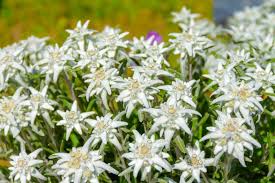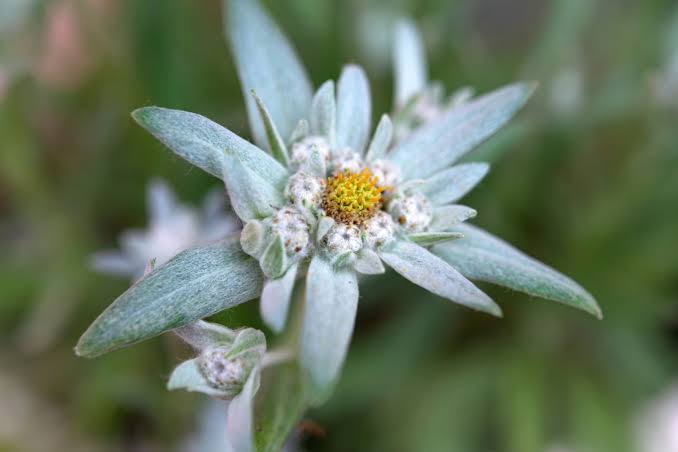Edelweiss flower, with its delicate yet rugged beauty, has captured the hearts of many nature enthusiasts and admirers of alpine landscapes. This exquisite bloom, scientifically known as Leontopodium alpinum, thrives in the majestic heights of the Swiss and Austrian Alps, where it adds a touch of charm to the rugged terrain.
One cannot help but be captivated by the unique appearance of the Edelweiss. Its small, star-shaped blossoms boast velvety petals that create an enchanting contrast against the backdrop of rocky slopes and snow-capped peaks. The flowers’ woolly, silvery-gray appearance lends them an air of resilience, a testament to their ability to survive in extreme mountain conditions.
Despite its delicate appearance, the Edelweiss is a hardy perennial plant. Its adaptation to the harsh alpine environment can be seen in its growth pattern and structure. The Edelweiss tends to grow close to the ground, hugging the crevices of rocky terrains. This low-growing habit helps protect it from strong winds and preserves moisture in the arid alpine soil.
Beyond its visual appeal, the Edelweiss carries cultural and historical significance. For centuries, this alpine flower has been cherished by mountaineers, hikers, and botany enthusiasts alike. It has become an emblem of alpine regions, symbolizing courage, purity, and the resilience of nature in the face of adversity.
Due to its popularity and delicate nature, the Edelweiss has faced challenges in the form of over-harvesting and habitat degradation. In response, efforts have been made to protect and conserve this precious flower. Today, it is protected by law in many alpine countries, ensuring its preservation for future generations to enjoy.
The allure of the Edelweiss has extended beyond its natural habitat, inspiring artistic and cultural expressions. Its beauty has been immortalized in poems, songs, and literature, becoming a beloved icon that transcends geographical boundaries. The Edelweiss has even made its mark in the world of fashion and design, adorning jewelry, textiles, and various accessories, where it continues to evoke a sense of alpine elegance.
For those fortunate enough to witness the Edelweiss in its natural environment, it is an experience that leaves a lasting impression. It serves as a reminder of the awe-inspiring beauty and resilience of nature, a fragile yet enduring reminder that life can flourish even in the harshest of conditions.
In addition, the Edelweiss flower stands as a symbol of alpine beauty, captivating all who encounter it. Its delicate yet hardy nature, its cultural significance, and its timeless appeal have solidified its place as a beloved flower. As we continue to appreciate and protect this precious bloom, we celebrate not only its aesthetic charm but also the spirit of resilience and wonder that it embodies.
History And Significance of Edelweiss Flower
The history and significance of the Edelweiss flower can be traced back to the alpine regions of Europe, particularly Switzerland and Austria. The name “Edelweiss” is derived from the German words “edel,” meaning noble, and “weiß,” meaning white. This beautiful flower has captured the imagination of people for centuries and has become an enduring symbol of alpine beauty and resilience.
The Edelweiss has a rich cultural and historical significance, deeply rooted in the mountainous regions where it thrives. Historically, the flower was associated with mountain climbers and alpine communities, as it was often found in high-altitude regions that were challenging to access. It became a symbol of courage, adventure, and the indomitable spirit of those who ventured into the mountains.
During the golden age of alpinism in the 19th century, when mountaineering and exploration of the Alps gained popularity, the Edelweiss began to acquire a special meaning. It became a talisman for climbers, carried with them as a good luck charm and a symbol of their love for the mountains. Its scarcity and the difficulty of obtaining it added to its allure and prestige.
The Edelweiss flower also holds significance in traditional folklore and legends. In Alpine folklore, it was believed that the Edelweiss possessed magical properties. It was associated with love, purity, and eternal loyalty. According to legends, giving an Edelweiss to a loved one was seen as a gesture of devotion and commitment.
Furthermore, the Edelweiss flower gained international recognition and popularity through its association with the famous song “Edelweiss” from the musical “The Sound of Music.” This iconic song, written by Richard Rodgers and Oscar Hammerstein II, expresses love and nostalgia for the Austrian homeland and has helped to spread the fame of the Edelweiss far beyond its native mountains.
Over time, the Edelweiss has become a national symbol for both Austria and Switzerland. It is featured in their respective coat of arms, representing the beauty, purity, and resilience of their alpine landscapes. The flower has also been used to adorn traditional clothing, such as dirndls and lederhosen, further emphasizing its cultural significance.
In recent years, efforts have been made to protect and conserve the Edelweiss due to its vulnerability to over-harvesting and habitat degradation. It is now a protected species in many alpine countries, and regulations are in place to prevent its unauthorized collection. Conservation projects and awareness campaigns aim to preserve this iconic flower for future generations.
In addition, the history and significance of the Edelweiss flower are deeply intertwined with the alpine regions where it grows. From its association with mountaineering and adventure to its cultural symbolism and international recognition, the Edelweiss represents the spirit of the mountains and captures the imagination of people worldwide. It serves as a reminder of the beauty, resilience, and cultural heritage of the alpine landscapes it calls home.
Read Also: Harvesting and Processing Of Cacao Fruits
Complete Growing Guide For Edelweiss Flower

Growing Edelweiss can be a rewarding endeavor, but it’s important to note that they have specific requirements and can be challenging to cultivate. Here are some general guidelines to help you get started on growing Edelweiss:
1. Climate and Location:
Edelweiss thrives in cool alpine environments. If you live in a region with a similar climate, you’ll have better success growing them.
Choose a location that receives plenty of sunlight but also has good air circulation.
Provide some shade during the hottest part of the day to protect the plants from intense sunlight.
2. Soil Conditions:
Edelweiss prefers well-draining soil. It is crucial to ensure proper drainage to prevent waterlogging, as Edelweiss is susceptible to root rot.
The soil should be slightly acidic to neutral, with a pH ranging from 6.0 to 7.0.
Improve the soil by adding organic matter such as compost to enhance drainage and fertility.
3. Propagation:
Edelweiss can be propagated from seeds or cuttings.
If starting from seeds, sow them in a well-draining potting mix in early spring or late summer. Keep the soil moist but not soggy. Germination can take several weeks.
Cuttings can be taken from healthy, established plants. Use a rooting hormone to enhance success rates and plant them in a well-draining medium.
4. Watering and Moisture:
Edelweiss prefers moderate moisture levels. Water the plants regularly but avoid overwatering.
Allow the soil to dry out slightly between watering sessions to prevent waterlogged conditions.
During winter, reduce watering as the plants go into dormancy.
5. Temperature and Winter Care:
Edelweiss is adapted to cool temperatures and may struggle in hot climates. Provide some shade or protection during the hottest part of the day.
In winter, Edelweiss goes dormant. Mulch the plants with a layer of straw or dry leaves to protect them from extreme cold.
If you live in a region with harsh winters, consider growing Edelweiss in containers that can be brought indoors during the coldest months.
6. Maintenance and Care:
Remove weeds regularly to prevent competition for nutrients and moisture.
Deadhead spent flowers to encourage more blooms and prevent self-seeding.
Edelweiss can be sensitive to pests and diseases. Monitor for any signs of problems and take appropriate measures, such as using organic pest control methods.
It’s essential to note that Edelweiss can be challenging to grow outside their native alpine environments. If you live in a region with a different climate, it may be more practical to enjoy Edelweiss through visiting alpine gardens or seeking potted specimens that can be kept indoors or in a controlled environment.
Read Also: Products That Can Be Made From Cocoa
Uses of Edelweiss Flower

The Edelweiss flower has various uses and applications beyond its aesthetic appeal. Here are some notable uses of Edelweiss:
1. Ornamental Purposes:
Edelweiss is highly valued for its beauty and uniqueness, making it a sought-after ornamental plant in gardens and landscaping.
The delicate white blooms and woolly appearance of Edelweiss add charm and elegance to alpine-themed gardens, rockeries, and flower arrangements.
2. Traditional and Cultural Symbol:
The Edelweiss flower holds significant cultural and symbolic value in alpine regions, particularly in Austria and Switzerland.
It is featured in traditional clothing, such as dirndls and lederhosen, serving as a symbol of national identity and alpine heritage.
Edelweiss is associated with qualities such as courage, purity, love, and loyalty, making it a cherished emblem in folklore, songs, and poetry.
3. Medicinal and Herbal Remedies:
Edelweiss has a long history of use in traditional medicine in alpine regions.
The flower and leaves of Edelweiss are believed to possess medicinal properties, such as anti-inflammatory and antioxidant effects.
Extracts derived from Edelweiss have been used topically in skincare products to soothe and protect the skin from environmental stressors.
4. Cosmetics and Skincare:
The unique properties of Edelweiss have made it a sought-after ingredient in the cosmetic and skincare industry.
Extracts of Edelweiss are used in creams, lotions, serums, and sunscreens due to their potential anti-aging, antioxidant, and protective effects on the skin.
Edelweiss is valued for its ability to combat free radicals, support skin regeneration, and provide hydration.
5. Souvenirs and Crafts:
The popularity of Edelweiss has led to its use in souvenir items, such as keychains, jewelry, embroidered patches, and decorative items.
Crafters and artisans incorporate dried Edelweiss flowers into various creations, including pressed flower art, resin jewelry, and floral arrangements.
6. Culinary Applications:
In some alpine regions, Edelweiss has been used in traditional culinary practices, although it is not as common as its other uses.
The flowers can be used as a decorative element in salads, desserts, and beverages, adding a touch of alpine flair.
It’s important to note that while Edelweiss has been traditionally used in certain applications, its availability and use may vary depending on local regulations, conservation efforts, and cultural practices. Additionally, some uses of Edelweiss, such as medicinal or cosmetic applications, may require proper extraction and formulation techniques to ensure safety and efficacy.
Read Also: Revolutionizing Wastewater Treatment
